#Oglala Lakota
Text
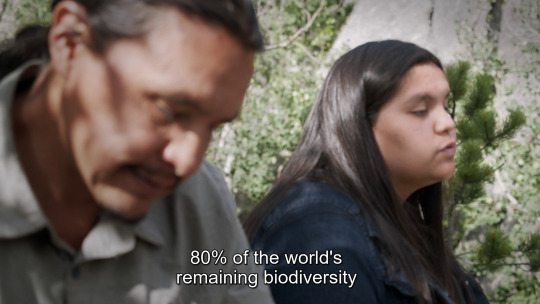


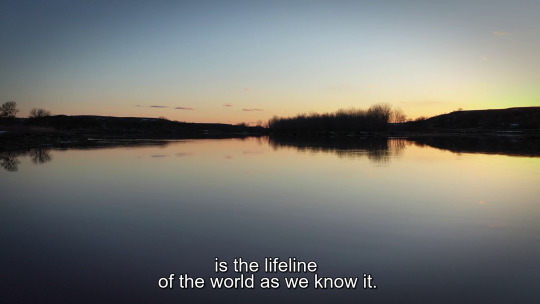
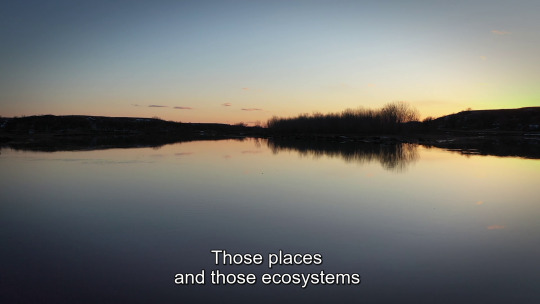
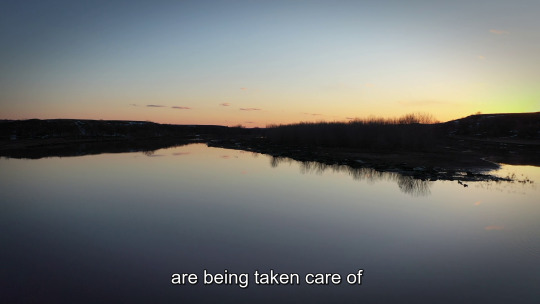








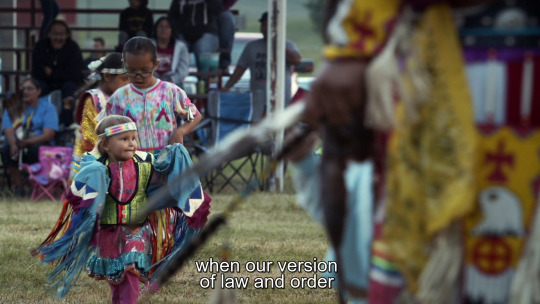

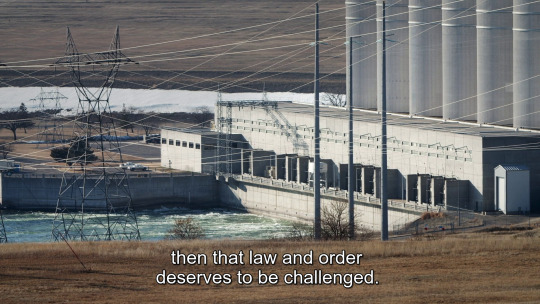
Chase Iron Eyes & Tokata Iron Eyes in Oyate (2022)
#native american#oglala lakota#dapl#indigineous people#indigenous#tokata iron eyes#chase iron eyes#biodiversity#dakota access pipeline
29K notes
·
View notes
Text
🏆 Photography 🏆

Quannah Chasinghorse, Fist Raised by Kiliii Yuyan
Quannah Chasinghorse, a groundbreaking Indigenous model, stands tall and confident, her gaze piercing through the lens to remind viewers “whose land you’re living on”. Using her fame to support activism, Chasinghorse’s assertive presence speaks to her dedication to creating positive change and elevating the voices of marginalized communities.


Quannah Rose Chasinghorse (born June 7, 2002) is a Native American model and fierce land protector who is an advocate for causes that affect her community. Her Indigenous ancestry is both Hän Gwich’in (from Alaska and Canada) and Oglala Lakota (from South Dakota)
Now that Chasinghorse has catapulted into the spotlight, walking the runways of Prabal Gurung, Chloé, and Chanel (among others) and attending the Met Gala, she's using her platform to advocate for change. She is using her unique beauty to forward the narrative of protecting indigenous lands, their people, and their animals while killing it as a model.
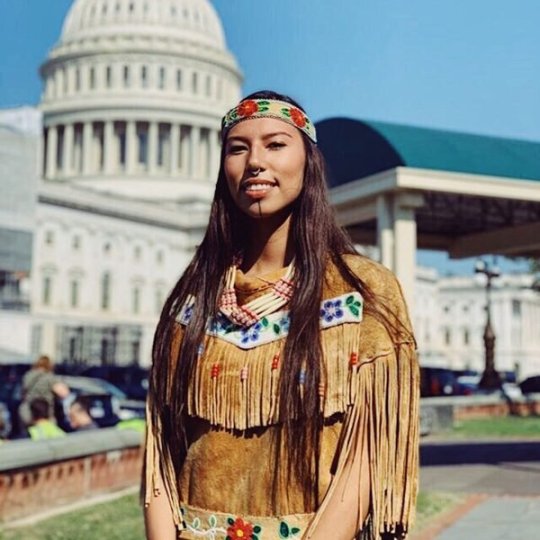
#photography#indigenous#native american#quannah chasinghorse#Chloé#chanel#model#Oglala Lakota#Hän Gwich’in#Kiliii Yuyan#advocate#cliff clavin
498 notes
·
View notes
Text
https://ictnews.org/news/big-pink-truck-delivers-books-love-of-native-literature

https://ictnews.org/news/big-pink-truck-delivers-books-love-of-native-literature
The truck is from the founders of the NDN Book Club, Kinsale Drake, Navajo, and Pte San Win Little Whiteman, Oglala Lakota. The club truck hit the road April 1-5. In addition to distributing books, the team handed out product donations curated by sponsor Amy Denet Deal from 4KINSHIP, a Navajo brand that uses runway fashion to fund social good projects on Navajo Nation like the Yilta Book Drop.
NDN Book Club is a nonprofit, literary organization run by and for Indigenous peoples that hosts free youth workshops, author talks, uplifts Indigenous literature, supports Indigenous booksellers, and sends out free Native books. They are supported by Native actress Amber Midthunder (“Prey”) and model activist Quannah Chasinghorse.
In 2023, they distributed more than 2,000 free books by Indigenous authors to Native youth across Turtle Island, supplied by diverse Indigenous booksellers, publishers and authors. From Muckleshoot in Washington to Piscataway lands in the Northeast, they lead workshops in classrooms, tribal libraries, tribal colleges, book festivals and museums.
#indigenous#native american#books#navajo nation#oglala lakota#indigenous people#indigenous writers#indigenous artists#good news#ndn#literature#native literature
70 notes
·
View notes
Text
On September 6th, we venerate Ancestor Tašhúŋka Witkó aka "Crazy Horse" on the 146th anniversary of his passing 🕊
[for our Hoodoos of First Nations descent]

Crazy Horse was the legendary Oglala Lakota Warrior who spearheaded the war against invading colonizers sweeping the land & recognized as a great leader committed to preserving the traditions and values of the Lakota ways of life.
Tašhúŋka Witkó was born into war; at a time when the European colonizer threat was growing, encroaching on sacred land & driving friction between Indian communities. Even as a boy, the warrior spirit was strong in him. He raided horses from Crow Nation at age 13. Once he came of age, he took up initiation through Vision Questing. Tašhúŋka Witkó fasted alone in the wilderness for four days and nights seeking guidance from Great Spirit. What he received from this monumental moment would chart his course through life as the greatest warrior his People had ever known. He earned his reputation among the Lakota, not only by skill, but also by his fierce determination to preserve the traditions of his people. He was known for refusing to be photographed, leading with the traditional belief that by doing so would capture an essence of his soul.
By his mid-teens, Tašhúŋka Witkó (by then Crazy Horse) was already a full-fledged warrior; known for his staggering bravery and prowess on the battlefield. He rode into battle with a hawk feather in his hair, a rock behind his ear, & a lightning bolt slashed across his face. The ancestral mysticism and rituals that went into preparing him for battle is what blessed him with the power & protection to succeed.
He led his first war party in Oglala Chief Red Cloud's war against the European colonizers invading lands Wyoming from 1865-1868. He met U.S. forces in open battle for the first time in 1876 after he became a resistance leader against the Lakota being forced onto reservations. He led a band of Lakota Warriors alongside Sitting Bull, the Cheynne, & other neighboring Tribes in counterattack in the Battle of Little Bighorn against Custer’s 7th U.S. Cavalry Battalion. Custer, 9 of his officers, & 280 soldiers, all lay dead in his wake. From then on, the U.S. Gov. targeted the Northern Plains tribes who resisted its encroachment. After a year of forcing the displacement of many Indigenous communities, slaughtering the Buffalo population, and driving their starvation into surrender, eventually the same fate fell upon the Olglala Band of Lakota Nation. In 1877, under a truce flag, Crazy Horse traveled to Fort Robinson to negotiate terms of mutual surrender.
Negotiations with U.S. Military leaders broke down, allegedly as a result of the translator's incorrectly translationof what Crazy Horse said, which spurred them to quickly imprison Crazy Horse. Once he realized their scheme, Crazy Horse broke free & drew his knife. A infantry guard made a successful lunge with a bayonet and mortally wounded him. Crazy Horse succumbed to his wound shortly thereafter once it became infected. After his death, his parents buried him at an undisclosed location near Wounded Knee, South Dakota. There he rests among with the Ancestors he venerate so deeply.
"[ “Where are your lands now?”] “My lands are where my dead lie buried.” - Crazy Horse's response to a U.S. Cavalry man's taunts at the Battle of Little Big Horn.
We pour libations & give him💐 today as we celebrate him for his unbridled warrior spirit, his leadership, prowess, & for being a beacon of light leading all Indigenous American descendants back to our traditional ways of life.
Offering suggestions: prayers toward his elevation, libations of water, offerings of tobacco, & Oglala Lakota songs/prayers
‼️Note: offering suggestions are just that & strictly for veneration purposes only. Never attempt to conjure up any spirit or entity without proper divination/Mediumship counsel.‼️
#hoodoo#hoodoos#atr#atrs#the hoodoo calendar#Crazy Horse#Tašhúŋka Witkó#lakota nation#oglala band#oglala lakota#land back#ancestor elevation#first nations#american indian#black indigenous#indigenous americans
59 notes
·
View notes
Link
Kalle Banaille - Indian Country Today
Legacy of Wounded Knee occupation lives on 50 years later
The occupation of Wounded Knee, South Dakota, began 50 years ago and was one in a string of protests from 1969 to 1973 that pushed the American Indian Movement to the forefront of Native activism
WOUNDED KNEE, S.D. (AP) — Madonna Thunder Hawk remembers the firefights.
As a medic during the occupation of Wounded Knee in early 1973, Thunder Hawk was stationed nightly in a frontline bunker in the combat zone between Native American activists and U.S. government agents in South Dakota.
“I would crawl out there every night, and we’d just be out there in case anybody got hit,” said Thunder Hawk, of the Oohenumpa band of the Cheyenne River Sioux Tribe, one of four women assigned to the bunkers.
Memories of the Wounded Knee occupation — one in a string of protests from 1969 to 1973 that pushed the American Indian Movement to the forefront of Native activism — still run deep within people like Thunder Hawk who were there.
Thunder Hawk, now 83, is careful about what she says today about AIM and the occupation, but she can’t forget that tribal elders in 1973 had been raised by grandparents who still remembered the 1890 slaughter of hundreds of Lakota people at Wounded Knee by U.S. soldiers.
“That’s how close we are to our history,” she told ICT recently. “So anything that goes on, anything we do, even today with the land-back issue, all of that is just a continuation. It’s nothing new.”
Other feelings linger, too, over the tensions that emerged in Lakota communities after Wounded Knee and the virtual destruction of the small community. Many still don’t want to talk about it.
But the legacy of activism lives on among those who have followed in their footsteps, including the new generations of Native people who turned out at Standing Rock beginning in 2016 for the pipeline protests.
“For me, it’s important to acknowledge the generation before us — to acknowledge their risk,” said Nick Tilsen, founder of NDN Collective and a leader in the Standing Rock protests, whose parents were AIM activists. “It’s important for us to honor them. It’s important for us to thank them.”
Akim D. Reinhardt, who wrote the book, “Ruling Pine Ridge: Oglala Lakota Politics from the IRA to Wounded Knee,” said the AIM protests had powerful social and cultural impacts.
“Collectively, they helped establish a sense of the permanence of Red Power in much the way that Black Power had for African Americans, a permanent legacy,” said Reinhardt, a history professor at Towson University in Towson, Maryland.
“It was the cultural legacy that racism isn’t OK and people don’t need to be quiet and accept it anymore,” he said. “That it’s OK to be proud of who you are.”
A series of events in South Dakota in recent days recognized the 50th anniversary of the occupation, including powwows, a documentary film showing and a special honor for the women of Wounded Knee.
‘‘THUNDERBOLT’ OF PROTEST
The occupation began on the night of Feb. 27, 1973, when a group of warriors led by Oklahoma AIM leader Carter Camp, who was Ponca, moved into the small town of Wounded Knee. The group took over the trading post and established a base of operations along with AIM leaders Russell Means, of the Oglala Sioux Tribe; Dennis Banks, who was Ojibwe; and Clyde Bellecourt, of the White Earth Nation.
Within days, hundreds of activists had joined them for what became a 71-day standoff with the U.S. government and other law enforcement.
It was the fourth protest in as many years for AIM. The organization formed in the late 1960s and drew international attention with the occupation of Alcatraz in the San Francisco Bay from 1969-1971. In 1972, the Trail of Broken Treaties brought a cross-country caravan of hundreds of Indigenous activists to Washington, D.C., where they occupied the U.S. Bureau of Indian Affairs headquarters for six days.
Then, on Feb. 6, 1973, AIM members and others gathered at the courthouse in Custer County, South Dakota, to protest the killing of Wesley Bad Heart Bull, who was Oglala Lakota, and the lenient sentences given to some perpetrators of violence against Native Americans. When they were denied access into the courthouse, the protest turned violent, with the burning of the local chamber of commerce and other buildings.
Three weeks later, AIM leaders took over Wounded Knee.
“It had been waiting to happen for generations,” said Kevin McKiernan, who covered the Wounded Knee occupation as a journalist in his late 20s and who later directed the 2019 documentary film, “From Wounded Knee to Standing Rock.”
“If you look at it as a storm, the storm had been building through abuse, land theft, genocide, religious intoleration, for generations and generations,” he said. “The storm built up, and built up and built up. The American Indian Movement was simply the thunderbolt.”
The takeover at Wounded Knee grew out of a dispute with Oglala Sioux tribal leader Richard Wilson but also put a spotlight on demands that the U.S. government uphold its treaty obligations to the Lakota people.
By March 8, the occupation leaders had declared the Wounded Knee territory to be the Independent Oglala Nation, granting citizenship papers to those who wanted them and demanding recognition as a sovereign nation.
The standoff was often violent, and supplies became scarce within the occupied territory as the U.S. government worked to cut off support for those behind the lines. Discussions were ongoing throughout much of the occupation, with several government officials working with AIM leaders to try and resolve the issues.
The siege finally ended on May 8 with an agreement to disarm and to further discuss the treaty obligations. By then, at least three people had been killed and more than a dozen wounded, according to reports.
Two Native men died. Frank Clearwater, identified as Cherokee and Apache, was shot on April 17, 1973, and died eight days later. Lawrence “Buddy” Lamont, who was Oglala Lakota, was shot and killed on April 26, 1973.
Another man, Black activist Ray Robinson, who had been working with the Oglala Sioux Civil Rights Organization, went missing during the siege. The FBI confirmed in 2014 that he had died at Wounded Knee, but his body was never recovered. A U.S. marshal who was shot and paralyzed died many years later.
Camp was later convicted of abducting and beating four postal inspectors during the occupation and served three years in federal prison. Banks and Means were indicted on charges related to the events, but their cases were dismissed by a federal court for prosecutorial misconduct.
Today, the Wounded Knee National Historic Landmark identifies the site of the 1890 massacre, most of which is now under joint ownership of the Oglala Sioux and Cheyenne River Sioux tribes.
The tribes agreed in 2022 to purchase 40 acres that included the area where most of the carnage took place in 1890, the ravine where victims fled and the area where the trading post was located.
The purchase, from a descendant of the original owners of the trading post, included a covenant requiring the land to be preserved as a sacred site and memorial without commercial development.
And though internal tensions emerged in the AIM organization in the years after the Wounded Knee occupation, AIM continues to operate throughout the U.S. in tribal communities and urban areas.
In recent years, members participated in the Standing Rock protests and have persisted in pushing for the release from prison of former AIM leader Leonard Peltier, who was convicted of two counts of first-degree murder despite inconsistencies in the evidence in the deaths of two FBI agents during a shootout in 1975 on the Pine Ridge Indian Reservation.
A NEW GENERATION
Tilsen, now president and chief executive of NDN Collective, an Indigenous-led organization centered around building Indigenous power, traces the roots of his activism to Wounded Knee.
His parents, JoAnn Tall and Mark Tilsen, met at Wounded Knee, and he praises the women of the movement who sustained the traditional matriarchal system during the occupation.
“I grew up in the American Indian Movement,” said Tilsen, a citizen of the Oglala Lakota Nation. “It wasn’t a question about what you were fighting for. You were raised up in it. In fact, if you didn’t fight, you weren’t going to live.”
Tilsen credits AIM and others for most of the rights Native Americans have today, including the ability to operate casinos and tribal colleges, enter into contracts with the federal government to oversee schools and other services, and religious freedom.
He said the movement showed the world that tribes were sovereign nations and their treaties were being violated. And when AIM and spiritual leaders such as Henry Crow Dog, Leonard Crow Dog and Matthew King joined the fight, it became intergenerational.
“It became a spiritual revolution,” he said. “It also became a fight that was about human rights. It became a fight that was about where Indigenous people aren’t just within the political system of America, but within the broader context of the system; of the world.”
Tilsen appreciates that his parents were willing to participate in an armed revolution to achieve one of their dreams of establishing KILI radio station, known as the “Voice of the Lakota Nation,” which began operating in 1983 as the first Indigenous-owned radio station in the United States.
The Dakota Access Pipeline protest in 2016 became a defining moment for him and his brother. They had wondered, he said, what would be their Wounded Knee?
“What made it so powerful and what made it different was that you actually had grassroots organizers and revolutionaries and official tribal governments coming together, too,” Tilsen said. “I think that Standing Rock in particular actually reached way further than Wounded Knee because of how the issue was framed around ‘water is life.’”
Alex Fire Thunder, deputy director of the Lakota Language Consortium, said the occupation of Wounded Knee and other activism helped revitalize Indigenous languages and cultures. His mother was too young to have participated in the occupation but he said she remembered visits from AIM members in the community.
“The whole point of AIM, the American Indian Movement, was to bring back a sense of pride in our culture,” Fire Thunder, Oglala Lakota, told ICT.
FUTURE GENERATIONS
For Thunder Hawk, the issues became her lifelong work rather than momentary activism.
She joined AIM in 1968 and participated in the occupation at Alcatraz, the BIA headquarters, the Custer County Courthouse and Wounded Knee, as well as the Standing Rock pipeline protest in 2016.
She said work being done today by a new generation is a continuation of the work her ancestors did.
“That’s why we were successful in Indian Country, because we were a movement of families,” she said. “It wasn’t just an age group, a bunch of young people carrying on.”
She hopes her legacy will live on, that her great-great-grandchildren will see not just a photo of her but know what she sounded like and the person she seemed to be.
It’s something that she can’t have when she looks at a photo of her paternal great-grandparents.
“Hopefully that’s what my descendants will see, you know?” she said. “And with the technology nowadays, they can press a button, maybe, and it’ll come up.”
Frank Star Comes Out, the current president of the Oglala Sioux Tribe, also believes it’s time for the previous generation’s work to be recognized.
Some of his family members strongly supported AIM, including his mother and father. He said it’s important to fight for his people, who survived genocide.
“That’s why I support AIM, not only on a family level,” he said. “I have a lot of pride in who I am as a Lakota. … Times (have) changed. Now I’m using my leadership to help our people rise, to give them a voice. And I believe that’s important for Indian Country.”
Kalle Benallie - Indian Country Today, February 27th 2023
248 notes
·
View notes
Text

Son of Chief American Horse ...
Charles American Horse of the Oglala Lakota ...
C. 1901 ...
Photo by William Herman Rau, via the Princeton Digital Library.
40 notes
·
View notes
Text
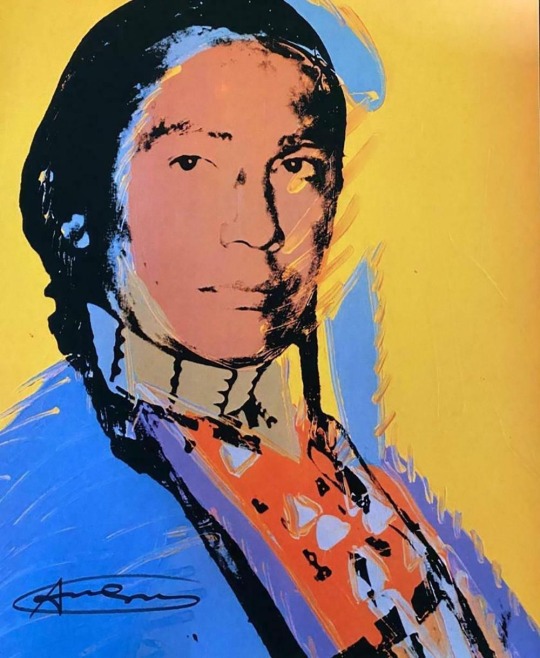
“What the American Indian Movement says is that the American Indians are the Palestinians of the United States, and the Palestinians are the American Indians of Europe” -Russell Means
Portrait of Russell Means by Andy Warhol
20 notes
·
View notes
Text
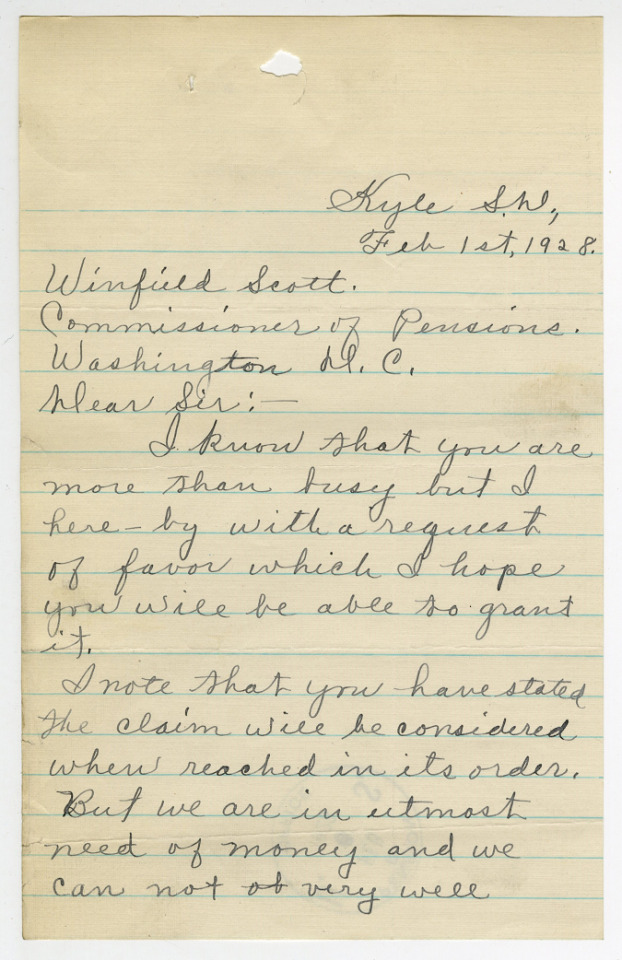
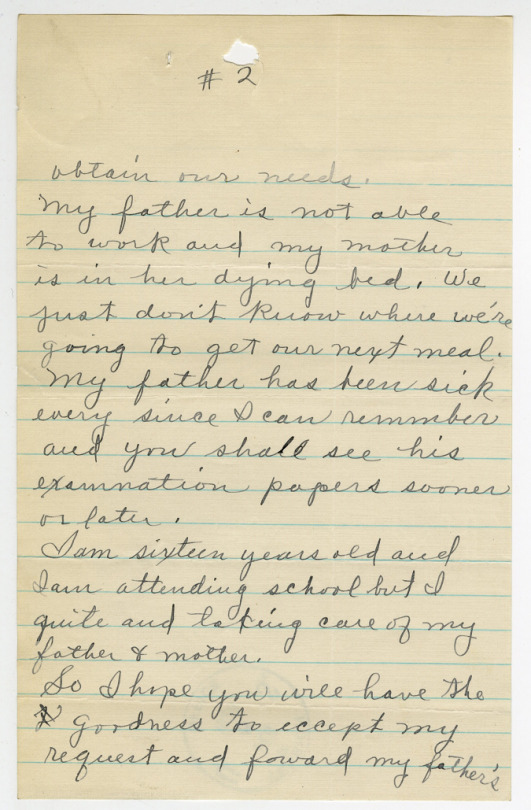

Sixteen-year-old Ruth Bluebird wrote to the Commissioner of Pensions on February 1, 1928, to try to speed along the approval for her father, former Oglala Lakota Indian Scout Jefferson Blue Bird (aka Zintka Tola).
His pension was approved six weeks later.
Record Group 15: Records of the Department of Veterans Affairs
Series: Case Files of Indian Wars Pension Applications
Transcription:
Kyle S.D.,
Feb 1st, 1928.
Winfield Scott.
Commissioner of Pensions.
Washington D.C.
Dear Sir: -
I know that you are more than busy but I here-by with a request of favor which I hope you will be able to grant it.
I note that you have stated the claim will be considered when reached in its order. But we are in utmost need of money and we can not ["ob" crossed out] very well
[page 2]
obtain our needs.
My father is not able to work and my mother is in her dying bed. We just don't know when we're going to get our next meal. My father has been sick every since I can remember and you shall see his examnation papers sooner or later.
I am sixteen years old and I am attending school but I quite and taking care of my father and mother.
So I hope you will have the [letter crossed out] goodness to eccept my request and forward my father's
[page 3]
[circled] O.K.
#3
[underlined] I.S.O. 16648
pension to him.
[underlined in red] Jefferson Bluebird
later [underlined in red] Co. D. Ind. Scts U.SA
I.S.O.
no. [underlined in red] 16648
Thank you in advance.
Very Respectfully,
I am Ruth Bluebird
#archivesgov#February 1#1928#1920s#Native American history#American Indian history#Indigenous American history#Oglala Lakota#Lakota Sioux#pine ridge reservation#military#U.S. Army#Indian Scouts
97 notes
·
View notes
Text

“Crazy Horse dreamed and went into the world where there is nothing but the spirits of all things. That is the real world that is behind this one, and everything we see here is something like a shadow from that one.” --Black Elk, Oglala Lakota
15 notes
·
View notes
Text
NICOTINE HARM PREVENTION
IF YOU CARE ABOUT THE PREVENTION OF LUNG CANCER, HEART CANCER, MOUTH CANCER, THROAT CANCER, AND ANY OTHER CANCER, REBLOG THIS POST.
Drug: Nicotine
Effects as a pure drug: Focus. A heightened state of awareness. General mental arousal that can be properly directed towards any task. Most people who abuse the drug do so because they are mentally ill or lack focus. This is a natural form of human behavior, called self-medication.
Best if: Treated like a medication, and not a treat.
Forms:
Cigarettes-- safer if smoked properly.
Tobacco chew- ABSOLUTELY DO NOT.
Nicotine gum-- This is pretty safe.
Nictotine patches- Do your own research.
Vape products-- See end of post.
PIPE HARM PREVENTION: unrecommended except for special or spiritual occasions. Try to use a filter of some kind. Cotton is preferable. Try not to light the cotton on fire. Using a small screen divider and wetting the cotton and placing it under the screen divider and placing the tobacco on top would be your best bet. Smoke it slowly and carefully, and do NOT torch the whole bowl of the pipe at once.
CIGARETTE HARM PREVENTION:
Before you smoke, lick your thumb or finger, and get plenty of spit on there. Place it on the end of the filter. (DO NOT SMOKE UNFILTERED CIGARETTES)-- and then blow into the end of the cigarette. The goal is to clog the filter with as much spit as possible to block as much tar from entering your lungs as possible. Gently squish the filter and roll it (not too much, you want your spit to be globby and catch as much tar as possible, so you don't want the liquid to be uniform throughout the filter.)--- and then gently wipe off the end of the cigarette until there's no liquid on the outside.
When you light your cigarette and inhale, if you hear hissing or bubbling from the cigarette, you are inhaling too hard, and spit full of tar is going to get on your lips. If this happens, spit it out immediately, or keep water nearby to rinse your mouth out (and spit afterwards). Do NOT inhale quickly. Inhale slowly, deeply, and calmly, for as long as possible, and let the smoke sit in your lungs for a few seconds for maximum "focus effect."-- and then, very shallowly inhale and exhale a few times to give the nicotine time to absorb. Finally, slowly fully exhale. There should be little to no smoke.
If you see brown dots along the paper or on the bottom of the filter, that's tar. That means that you've done it successfully. Try to keep your tongue from touching the bottom of the filter.
If during smoking you feel spit building up in the back of your throat, spit it out. Don't worry about being judged. Not getting throat or mouth or lung cancer is far, far more important.
Smoke the cigarette slowly until it is almost down to the filter, and then very carefully and quickly put it out to avoid secondhand smoke. Avoid breathing in the secondhand smoke.
If you feel yourself having issues breathing, stop for a day. A week is better, but giving your lungs a day to heal will do wonders.
Keep your cigarettes to a specific place. Don't allow yourself to carry them around. If you need to take them to work, hide them in a specific place. This is to control the urge and to make your brain realize that you need to work in order to gain the nicotine high. After awhile of doing this, your brain should automatically start recognizing the drug as a medication instead of a treat.
If you live at home or with others, hide them somewhere outside. Somewhere you have to actively go. This is to force you to realize that every time you smoke a cigarette, you have to make it a conscious choice. When you smoke, say to yourself in your head "I am choosing to smoke right now. I might not smoke when I feel the urge later. I will smoke when I choose to, whether I want it or not."
I do not expect you to quit cigarettes. They are a cheap and widely available form of drug that is the very most acceptable to abuse. But this drug belonged to the american natives, and it's been bastardized and mass-produced. You need to treat it with respect--- both to prevent cancer, and also to save money, and to keep in mind that the drug is not inherently yours. It is a natural product you consume, not an item you own.
VAPE HARM PREVENTION:
Do NOT smoke immediately after charging the device to its fullest capacity.
DO smoke when it's not completely charged.
Take slow, smooth, deep inhales for as long as you can, until you feel slightly dizzy or simply don't have the lung capacity to inhale anymore. Then, put the vape down and out of sight so you're not tempted to smoke it just because of the flavored air.
This is because vapes are the most dangerous when you accidentally burn the coil.
Try not to smoke from vapes that taste like almost nothing, or taste bad. Because they hardly contain nicotine, and you're just heating the cotton coil at that point.
There are no “bad” drugs. There are simply drugs, and the correct way to utilize them. Addiction is the abuse of any kind of drug, at all. Addiction is not shameful.
#shut up bubbz#smoking#cancer#important#signal boost#oglala lakota#tobacco#help#boost#vaping#bpd#adhd#thc#weed#education
31 notes
·
View notes
Text



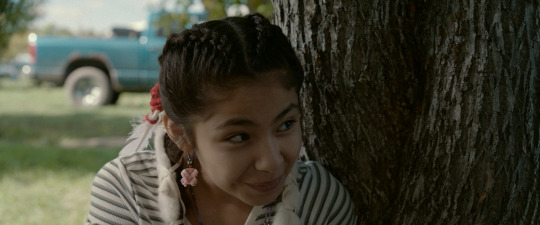
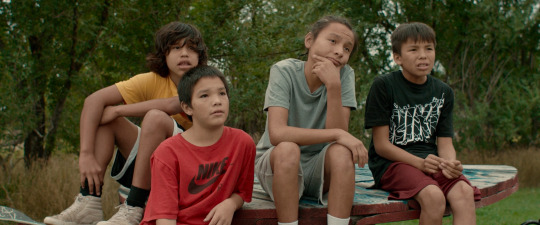

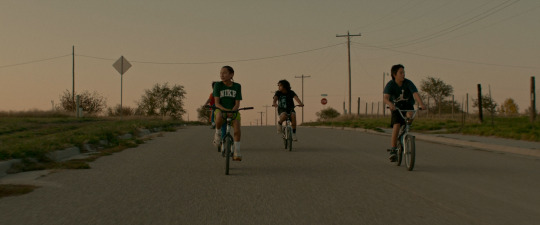
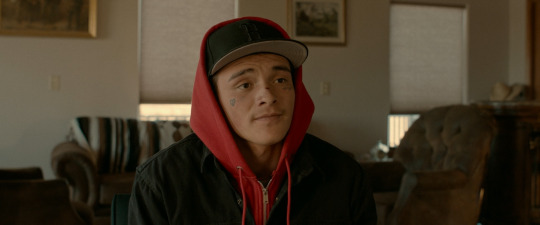


War Pony (Gina Gammell & Riley Keough, 2023)
#war pony#gina gammell#riley keough#oglala lakota#pine ridge#native people#sioux#female directors#female directed films#female filmmakers#female film directors#women in film#tongva people#oceti sakowin
82 notes
·
View notes
Text

Flying Hawk
Flying Hawk, also known as Moses Flying Hawk; March 1854 – December 24, 1931) was an Oglala Lakota warrior, historian, educator and philosopher. Flying Hawk's life chronicles the history of the Oglala Lakota people through the 19th and early 20th centuries, as he fought to deflect the worst effects of white rule; educate his people and preserve sacred Oglala Lakota land and heritage.

Chief Flying Hawk was a combatant in Red Cloud's War and in nearly all of the fights with the U.S. Army during the Great Sioux War of 1876. He fought alongside his first cousin Crazy Horse and his brothers Kicking Bear and Black Fox II in the Battle of the Little Big Horn in 1876, and was present at the death of Crazy Horse in 1877 and the Wounded Knee Massacre of 1890.
Chief Flying Hawk was one of the five warrior cousins who sacrificed blood and flesh for Crazy Horse at the Last Sun Dance of 1877. Chief Flying Hawk was the author of his commentaries and accounts of the Battle of the Little Big Horn, Crazy Horse and the Wounded Knee Massacre, and of Native American warriors and statesmen from who fought to protect their families, defend the invasion of their lands and preserve their culture. Chief Flying Hawk was probably the longest standing Wild Wester, traveling for over 30 years throughout the United States and Europe from about 1898 to about 1930. Chief Flying Hawk was an educator and believed public education was essential to preserve Lakota culture. He frequently visited public schools for presentations. Chief Flying Hawk leaves a legacy of Native American philosophy and his winter count covers nearly 150 years of Lakota history.
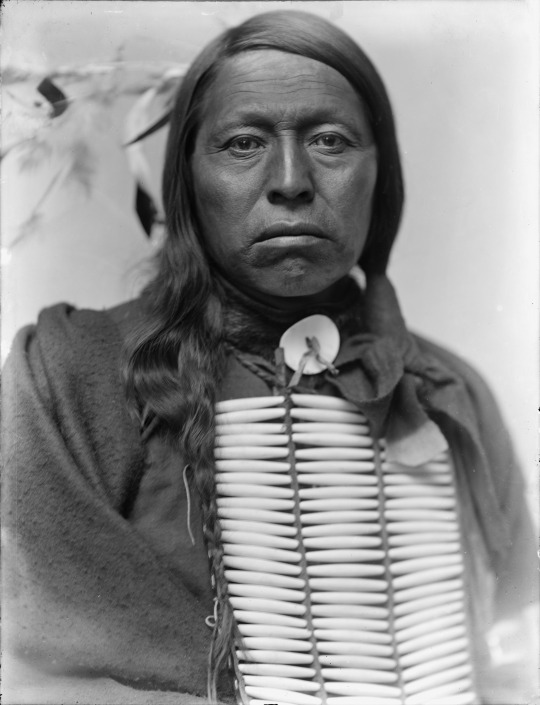
#historic photographs#chief flying hawk#lakota#sioux#little big horn#crazy horse#kicking bear#flying hawk#oglala lakota
170 notes
·
View notes
Text
https://ictnews.org/news/dancing-for-inclusion
https://ictnews.org/news/dancing-for-inclusion

54 notes
·
View notes
Text
On Dec 10th, we venerate Elevated Ancestor & Saint Maȟpíya Lúta aka Chief Red Cloud on the 113th anniversary of his passing 🕊 [for our Hoodoos of First Nations descent]

Red Cloud, Chief of the Oglala Sioux, was a political leader, a negotiator of peace, & fierce warrior who fought tirelessly to save his people from colonizer expansion into the midwest.
Maȟpíya Lúta was born near the forks of the Platte River, in what was at the time known as the Nebraska Territory; to his Ogala Lakota mother & Brulé Lakota leader father.
He showed great courage, strength, & leadership in battles against the Oglala's traditional competitors once he came of age; the Pawnees, Crows, Shoshones, & Utes. This ultimately earned him Chiefdom. He also successfully killed the usurper rival to his uncle's political leadership. This divided the Oglala for years to come.
Once European invaders discovered gold in Montana in the 1860s, they began dessimating habitats, sacred lands, & territories to build a road from Fort Laramie in present-day Wyoming to the gold fields. They constructed a series of forts to protect the road from interference, which became known as the Bozeman Trail. In 1865, Chief Red Cloud led the Ogala & their Cheyenne allies into a 2-year war against the colonizers along the Bozeman Trail. They were successful. The soldiers, miners, & others were forced to abandon their operation.
Being the peaceful negotiator that he was, at the end of the war, Chief Red Cloud signed the Second Treaty of Fort Laramie, which bound the U.S. to the promise that it would abandon the Bozeman Trail & return - what is now the western half of South Dakota, along with large parts of Wyoming, & Montana - to Lakota Sioux possession. In return, Red Cloud agreed to end his assault & relocate to a reservation in Nebraska known as the Red Cloud Agency.
In his older age, the great warrior became a diplomat of peace. In 1870s, Chief Red Cloud, along with several other First Nations leaders, traveled to D.C. to meet with U.S. President Grant. He later met with Grant again in 1875, when Grant has the caucasity to offer $25K to the Lakota if they would give up their rights to hunt along the Platte River in the Dakota Territory. Red Cloud, and other leaders, vehemently refused.
While Red Cloud pursued the path of peaceful negotiation & passive tactics, many other Indian leaders (including his own son) wanted to fight for their territory & ways of life. Red Cloud & President Grant sought to avoid war, but it was inevitable. After Sitting Bull's crushing defeat of a U.S. 7th Calvary in June of 1876, Whites began perpetuating aggressively negative campaigns & propaganda against First Nations in the West. Even still, Red Cloud resisted the call to war. He pursued diplomacy. In 1878, he successfully lobbied for the removal of the Indian agent at Pine Ridge Agency due to poor treatment. He returned to D.C. several more times to lobby for his people & defend the rights of all First Nations. This led him to become the most photographed Native of the 19th Century.
Red Cloud continued his work to preserve native lands & to maintain the authority of traditional First Nations leader until he was removed from political power; this may have been influenced by his shifting views in favor colonialism via Christianity & adopted the first name, "John". He later died on the Pine Ridge Agency with his wife; blind & ailing. There he rests in the cemetery so named after him.
"The Whites are the same everywhere. I see them every day. They made us many promises, more than I can remember, but they never kept but one; they promised to take our land, and they took it. " - Chief Red Cloud.
We pour libations & give him💐 today as we celebrate him for his spirit of resistance & immense peace. May we look to him for wise counsel, peaceful resolutions, & as a lesson in the influential power of colonialism.
Offering suggestions: River water, peace pipe, Lakota music, bison meat served with wild potatoes & prairie turnips
‼️Note: offering suggestions are just that & strictly for veneration purposes only. Never attempt to conjure up any spirit or entity without proper divination/Mediumship counsel.‼️
#hoodoo#hoodoos#atr#the hoodoo calendar#ancestor veneration#Elevated Ancestors#Chief Red Cloud#Red cloud#Lakota#First Nations#Plains Indians#Oglala#Oglala Lakota#Lakota Nation
22 notes
·
View notes
Text
South Dakota tribe banned Gov. Noem from reservation over comments on U.S.-Mexico border
A South Dakota tribe has banned Republican Gov. Kristi Noem from the Pine Ridge Reservation following her remarks on deterring immigration at the U.S.-Mexico border.
“Due to the safety of the Oyate, effective immediately, you are hereby Banished from the homelands of the Oglala Sioux Tribe!” Tribe President Frank Star Comes Out said in a statement on Friday.
“Oyate” means people or nation.
Star Comes Out accused Noem of using the border issues as a way to get former president Donald Trump re-elected and increase her chance of being his choice for vice president.
The tribal leader said some migrants coming to the U.S.-Mexico border are in search of a "better life" and are indigenous people from El Salvador, Guatemala, and Mexico.
“They don’t need to be put in cages, separated from their children like during the Trump Administration, or be cut up by razor wire furnished by, of all places, South Dakota,” he said.
10 notes
·
View notes
Photo
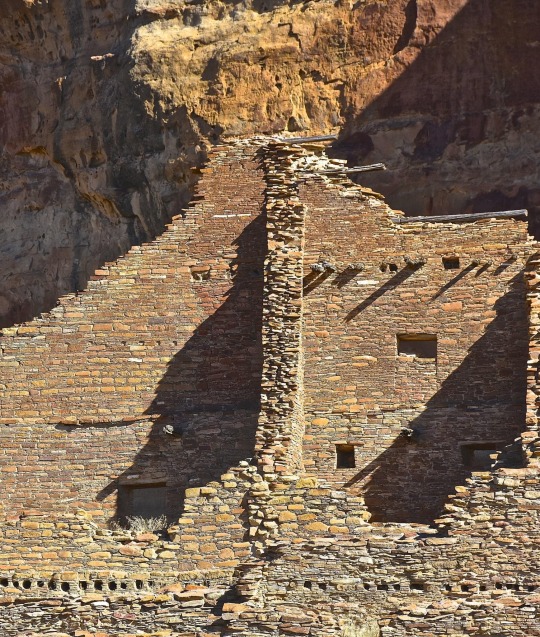
Pueblo Bonito in Chaco Canyon, San Juan Co, NM. Photo: James C Wilson (Apr 2023) :: [Scott Horton]
* * * *
“Crazy Horse dreamed and went into the world where there is nothing but the spirits of all things. That is the real world that is behind this one, and everything we see here is something like a shadow from that one.”
--Black Elk, Oglala Lakota
#Pueblo Bonito#Chaco Canyon#NM#James C Wilson#Scott Horton#Native American#Black Elk#Oglala Sioux#Oglala Lakota
42 notes
·
View notes